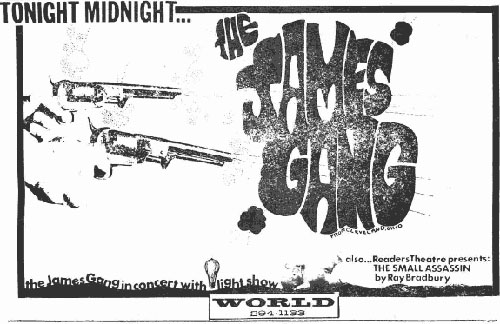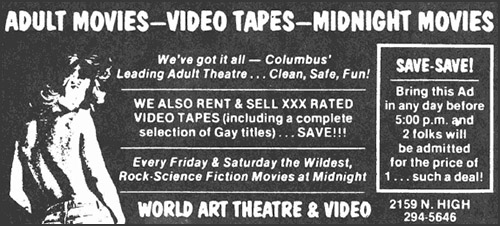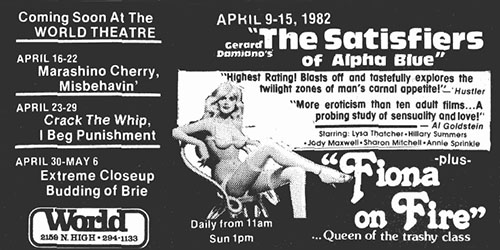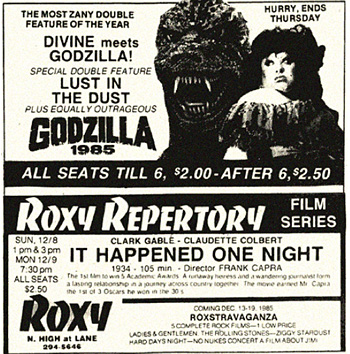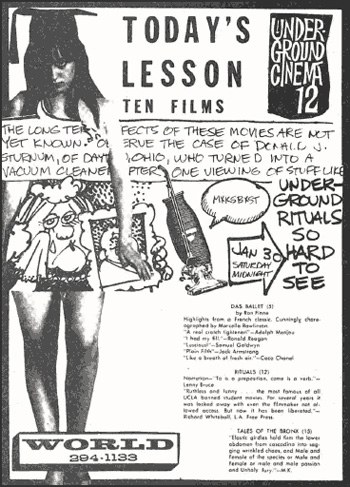 |
From 1967 to 1977, The World was host to Underground Cinema 12. Shown Fridays or Saturdays at midnight, UGC12 brought 90 minutes of avant-garde, experimental, and counterculture films from New York, San Francisco, and London to audiences in Columbus. UGC12 was created by Mike Getz, a relative of Art Theater Guild owner Louis Sher, who was involved in the underground film scene.
Art and experimental films like those of Andy Warhol, Stan Brakhage, Kenneth Anger, and Jonas Mekas were typical fare at UGC12 screenings. Psychedelic movies and light shows were popular with the often stoned crowd. Counterculture films mocking the war, The Establishment, Nixon, middle class values, etc. were sure hits. Depictions of then scandalous social groups--homosexuals, transvestites, occultists, nudists, junkies, etc.--were shown and enjoyed. Concert films of suitably trippy groups like The Plastic Ono Band, The Rolling Stones, or The Grateful Dead were occasionally screened as well. The films all had certain things in common: A counterculture sensibility; drug use, drug slang, and drug humor; heaping helpings of mostly female nudity and occasional heterosexual sex; irreverent and absurdist humor; repurposed music, TV and film footage, and imagery used for dramatic or humorous effect; lengthy (30 minute plus) close-ups of everyday activities; droning, repetitive soundtracks. Almost all of the films shared a homemade look and extremely low production values. Though they look pretty awful from 40 years later, these features were hugely influential. Mainstream culture like TV commercials, music videos, and early Saturday Night Live drew from underground cinema's inspiration. Many modern directors began in or were influenced by underground film. UGC12 itself pioneered the institution of the midnight movie and the idea of a cult film. |
The late 1960s also saw the theater branch out into live music performances. Local and touring regional groups gave live performances Friday nights at midnight at the movie theater to the acompaniment of trippy psychedelic light shows projected onto the screen behind the band. The most famous group to ever appear at The World was Cleveland, Ohio's up-and-coming hard rock band The James Gang. The James Gang appeared at The World in March 1969 and then returned for a double show in November. Venerable campus theatrical society The Strollers presented the anti-war play "Viet Rock" there in April 1969. |
|
In 1973, the World Theater marked sixty years as a movie theater. Somewhere along the way, it lost its marquee and picked up an ugly, black, wood and metal facade and a bright yellow, plastic sign; adopted, no doubt, to make the theater look more modern. At least it did away with the horrible Perma-Stone that had been attached to the facade in the late 1950s. While the theater remained a University District constant, the neighborhood around it had changed radically. The residential neighborhood south of E. Lane had disappeared, replaced by high-rise dorms. The student population of the district had more than doubled in just a decade. The University District had become one of the most densely populated areas in the state of Ohio. Homeowners, families, children, and old people left. Overcrowding, absentee landlords, shabby apartment buildings, bars, noise, crime, litter, and general squalor followed. |
||
| In the spring of 1977, The World changed formats again. The closure of the Little Art Theater at High & Tompkins opened a niche for another porn theater near campus. The close proximity of over 20,000 young males guaranteed an audience for adult product.
As before, the theater stayed in business by giving audiences features they couldn't see on television or in the big movie houses. Several other aging neighborhood theaters operated on this model. The old Hudson Theater at Hudson and Summit and the once grand Garden on High just south of Fifth both operated profitably as pornographic theaters. The Little Art (which had opened as the Piccadilly back in 1918) had also been successful as a porn house until the city condemned its building as unsafe. Social and cultural changes created a space for this business plan to work. The permissive attitudes of the early 1970s and the cross-over success of films like Deep Throat and Behind the Green Door had to some degree legitimated porn. While still not mainstream, it was not the scandal it had been just a few years earlier. X-rated theaters advertised in the newspapers like any other theater. As the campus area neighborhoods descended to their nadir, The World operated as a porn theater/sex shop exhibiting X-rated double features in the theater and vending adult magazines, videos, and sundries out front. Where Mary Pickford had once reigned, Marilyn Chambers was the new queen.
|
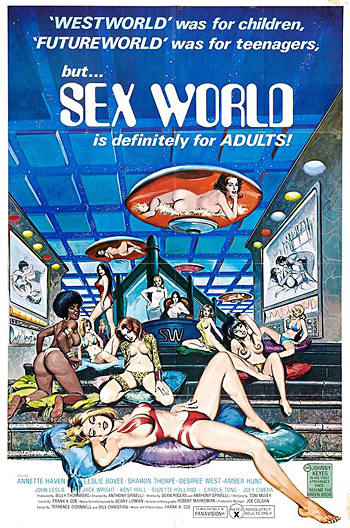 |
|
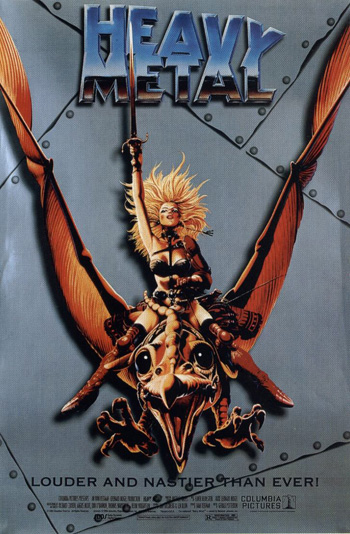 |
Ads for The World in 1981 (top) and 1982 (bottom).
|
The World ran porn films from 11 am until 2 am daily. The only break in this programming came on weekends when it hosted the Q-FM-96 Midnight Movies. WLVQ-FM was the big album-oriented rock radio station in the Columbus market at the time. Every teenager's radio was tuned to "The Q" and every teen's car sported a red and black Q-FM bumper sticker. In those pre-MTV days, the radio station promoted showings of rock-themed movies like Tommy, The Song Remains The Same, Heavy Metal, and The Wall at the World. The movies screened on Friday and Saturday nights at midnight to rowdy, often chemically enhanced, houses packed with teens and college students from around Central Ohio. A Burger King across the street that was open until 4 am, a couple adjacent bars, and a nearby liquor store added to the party atmosphere. The World’s career as a porn house was mercifully brief. Just as television had changed everything in the 1950s, new technology was about to change everything again. The proliferation of cable TV, VCRs, and video rentals in the early 1980s quickly and thoroughly destroyed the adult theater business. |
|
|
To survive, the theater had to adapt once more. The World found inspiration for its new direction in the success of its midnight movies. In September 1985, the World was rechristened as The Roxy and set itself up as a college movie theater. The closing of the University District's only other surviving theater, University Flick at 1980 N. High, in 1983 had opened up this niche. The Roxy's first film was the acclaimed Talking Heads concert film Stop Making Sense. The Roxy experimented with second-run movies, art pictures, independents, classics, and cult films. Pictures like Atomic Café and 3-D House of Wax packed the house. The Roxy’s animation, 3-D, Monty Python, and annual Rocky and Bullwinkle film festivals were well attended. Student groups and Ohio State departments arranged screenings of films. Filmmakers like cult auteur John Waters spoke and gave special screenings of their films at The Roxy. The theater again found itself the subject of controversy when it was picketed during a screening of Jean-Luc Goddard's Hail Mary. During its brief life, The Roxy was a movie-lover's paradise. Alas, it wasn’t enough. The home video revolution that had killed the porn theater was no kinder to the Roxy. Despite excellent programming and imaginative promotions, audiences continued to shrink. |
The Alhambra/World/Roxy’s seven plus decades as a theater ended in 1988. The venerable movie house showed its very last film on Thursday, June 2, 1988. The final movie ever shown at the theater was Vigil. The feature was oddly appropriate. A nearly dialogue-free, art film from New Zealand about a girl’s coming of age, it had elements of all the kinds of movies the theater had shown over the years. The Alhambra had been the first movie real theater in the University District back in 1913. At the time it closed its doors, it was the last. There wouldn't to be another movie theater in the University District until the Gateway Theater opened its doors in 2005. In the 32 years since the theater closed, the building has served as an athletic club and a succession of nightclubs. Around 2000, the building's facade was restored to its original brick. The ugly black metal and wood hoarding from the 1970s was scrapped. In the course of renovations, some of the original green tile and black marble from the building's 1913 entranceway was discovered. The owners placed a plaque there to commemorate the building's history. In 2014-15, the building was massively remodeled again and became Chop Shop, a gourmet hamburger restaurant.
|
 |
|
 |
||

